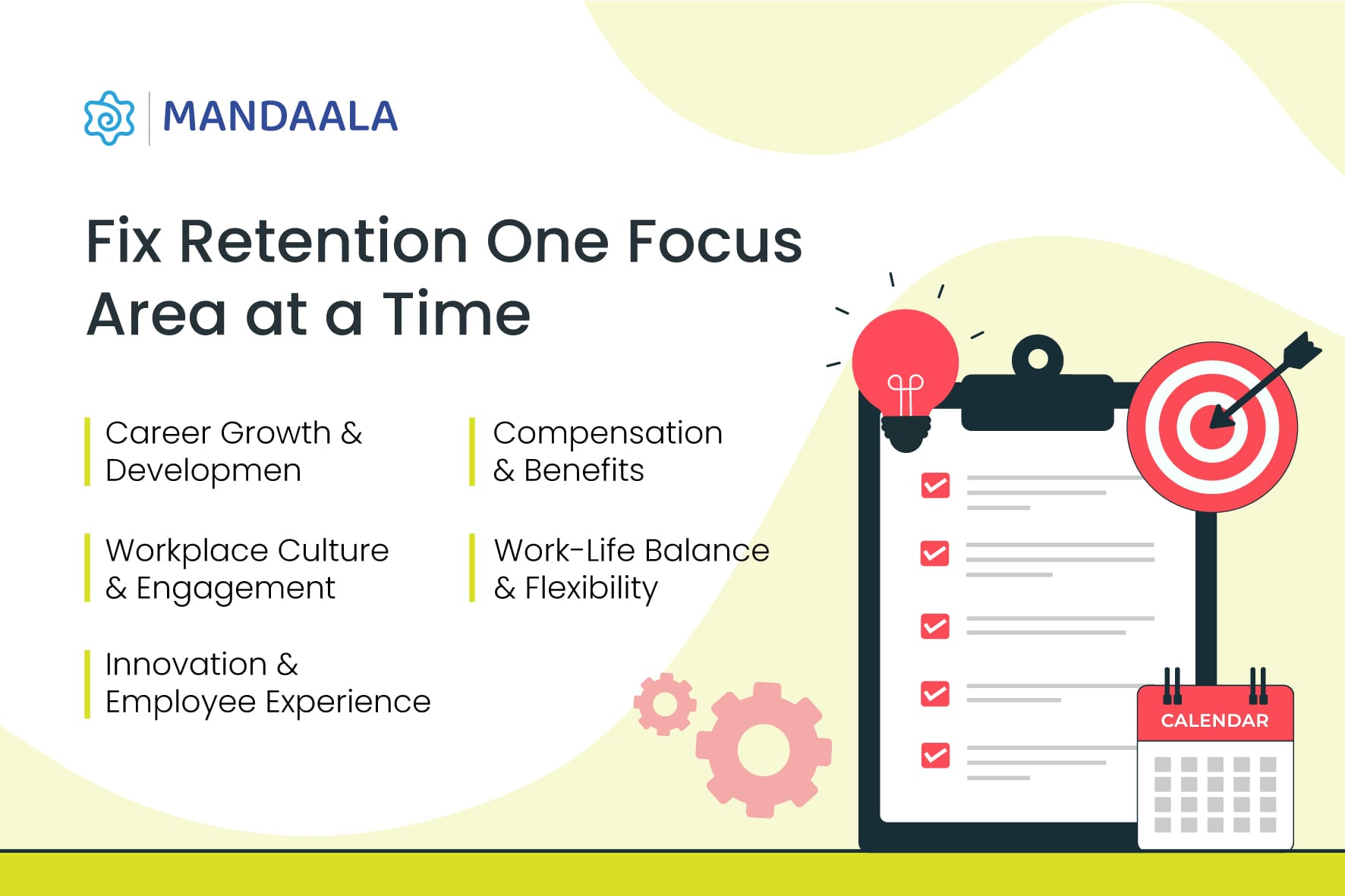18 Employee Retention Strategies to Keep Your Best Talent Engaged

Why do some companies keep their best people while others struggle with constant turnover? The answer often lies in how intentional they are about employee retention. When employees feel overlooked or stuck, even the best performers start scanning for the exit. But when organisations invest in growth, recognition, and flexibility, loyalty deepens. This article breaks down 18 employee retention strategies that will help you keep top talent engaged and committed.
What Is Employee Retention and Why It Is Important
Employee retention is the ability of an organisation to keep its people engaged and committed over time. It’s not just about reducing resignations, it’s about creating a workplace where employees see a future and feel motivated to stay. Strong staff retention strategies protect institutional knowledge, reduce the high costs of recruitment and training, and create stability across teams.
Beyond operations, retention has a powerful cultural impact. Employees who stay longer build stronger bonds, align with company values, and contribute to a positive environment. High retention boosts productivity, encourages collaboration, and signals to new hires that this is a workplace where careers thrive. In short, effective employee retention strategies turn consistency into loyalty, innovation, and long-term success.
18 Employee Retention Strategies

Here are 18 employee retention strategies, grouped into five key focus areas, that can help you build a workplace where people want to stay and grow.
A. Career Growth & Development
Employees don’t leave companies where they can grow. These strategies focus on building long-term career value, so your top talent stays for the journey, not just the job.
1. Offer clear career paths and promotion opportunities
Map out growth paths early and document them. When employees know how they can move up, and what’s expected to get there, it builds trust and long-term retention.
2. Provide training and skill development programs
Create learning budgets, host workshops or give access to upskilling platforms. Structured development shows you're invested in their future, not just their current role.
3. Support mentorship and coaching
Pair junior employees with mentors across teams. Internal coaching helps employees feel supported and increases retention by making guidance part of daily culture.
4. Encourage cross-functional experiences
Build rotation programs or short-term shadowing opportunities. This keeps work interesting, expands skill sets, and prevents employees from feeling stuck.
5. Conduct regular performance reviews with constructive feedback
Move beyond annual appraisals. Use monthly or quarterly 1:1s to give honest, useful feedback that focuses on progress, not just evaluation.
B. Compensation & Benefits
Fair pay and meaningful benefits are non-negotiables. These strategies help employees feel valued, not just for their work today, but for the future they’re building with you.
6. Competitive salaries and regular increments
Review and revise salary benchmarks at least once a year. Transparent pay bands and timely raises are among the most effective employee retention strategies for building trust.
7. Performance-based bonuses and incentives
Create reward systems linked to outcomes, monthly, quarterly, or project-based. This keeps motivation high and makes employees feel seen for the value they bring.
8. Flexible benefits and perks
Offer customisable perks instead of one-size-fits-all policies. Whether it’s wellness allowances or hybrid work setups, these staff retention strategies make work more livable.
9. Retirement plans and financial planning support
Support long-term goals, not just short-term wins. Tools like EPF top-ups, NPS, or financial coaching show you're thinking beyond payroll, you're investing in their future.
C. Workplace Culture & Engagement
Culture isn’t a poster on the wall, it’s what employees experience every day. These strategies to retain employees focus on recognition, inclusion, and making people feel like they belong.
10. Foster an inclusive and positive work environment
Audit policies, team rituals, and language through an inclusion lens. Create safe spaces for diverse voices and encourage openness across levels, it’s a powerful employee retention strategy that builds real connection.
11. Recognise and celebrate employee achievements
Set up regular recognition rituals, team shoutouts, milestone celebrations, or rewards for impact. Small, consistent moments of appreciation go a long way in any successful employee retention strategy.
12. Encourage employee feedback and suggestions
Use monthly pulse surveys or feedback boxes, and act on the insights. Employees stay when they feel heard, especially when their input shapes policies and decisions.
13. Organise team-building activities and events
Host quarterly offsites, interest-based clubs, or peer learning sessions. These informal touchpoints strengthen relationships and improve team dynamics, key staff retention strategies that build everyday engagement.
D. Work-Life Balance & Flexibility
No matter how great the job, if it drains people out, they won’t stay. These strategies help retain employees by supporting the balance they actually need.
14. Offer flexible working hours or remote options
Define clear boundaries around hybrid schedules, core hours, and expected availability. When flexibility is built into the system, not left to manager discretion, it becomes a reliable employee retention strategy.
15. Promote mental health and wellness initiatives
Set up wellness budgets, tie up with counselling platforms, or run monthly wellbeing check-ins. These small but consistent actions help reduce burnout and keep your staff retention strategies rooted in care.
16. Encourage taking breaks and vacations
Track unused leaves and prompt managers to help their teams schedule time off. When rest is normalised at every level, employees feel respected and are more likely to stay engaged.
E. Innovation & Employee Experience
Retention improves when everyday experiences feel intentional. These strategies use tech and personalisation to make work more meaningful, and harder to walk away from.
17. Implement innovative employee engagement tools
Use digital tools to simplify recognition, feedback, and internal communication. Automating small wins, like peer shoutouts or quick pulse surveys, makes engagement part of the workflow and strengthens your employee retention strategies.
18. Personalise work experience to align with individual preferences
Let employees choose how they celebrate milestones, receive rewards, or contribute to team rituals. This human-centred approach is one of the most impactful strategies to retain employees, especially in diverse, hybrid workplaces.
How to Implement These Strategies Successfully
Start by identifying where you’re losing people and why. If early attrition is high, prioritise onboarding and feedback. If mid-level churn is the issue, focus on career growth and recognition. The best employee retention strategies are targeted, not generic, they’re shaped by what your teams actually need.
Implementation only works when leaders set the tone. If flexibility, appreciation, or wellness aren’t modelled from the top, employees won’t take them seriously. For any staff retention strategy to succeed, commitment must show up in everyday behaviours, not just policies.
Finally, track what’s working. Use engagement surveys, exit data, and feedback to guide your next steps. Strategies to retain employees should evolve over time, driven by what your people are actually telling you.
Measuring Employee Retention Effectiveness

You can’t improve what you don’t measure. These simple metrics help track how well your employee retention strategies are actually working.
Turnover rate:
Track how many employees leave over a fixed period, rising numbers usually signal gaps in your staff retention strategies.
Employee satisfaction score :
Use quick surveys to understand how people feel about their roles, managers, and growth, satisfaction is a strong predictor of retention.
Engagement levels :
Monitor participation in initiatives, internal feedback loops, and recognition programs, engaged teams are more likely to stay.
Conclusion : Building Retention That Lasts
Employees don’t stay because of one great initiative, they stay because the everyday experience feels right. When people feel heard, supported, and excited about where they’re headed, they’re more likely to build their careers with you. That’s what strong employee retention strategies are really about, making work feel worth it, day after day.
There’s no perfect formula, but there is a clear way forward. Start with what your people need most, keep leadership involved, and treat feedback like fuel. The best strategies to retain employees evolve over time, becoming part of how your organisation thinks and operates. Retention isn’t a project, it’s a practice.
Mandaala is the solution arm of PrintStop India.